That registration requirement also led to some confusion because users wanted to be able to use existing websites that accept OpenID 2.0 compliant logins by simply entering gmail.com (or in some cases their E-mail address) into the login boxes on those websites. ... Once the XRDS file is live, end-users should be able to use the service by typing gmail.com in the OpenID field of any login box that supports OpenID 2.0, similar to how Yahoo users can type yahoo.com or their Yahoo E-mail address (In the meantime, if you feel really geeky, you can type https://www.google.com/accounts/o8/id into an OpenID 2.0 login box).Although these are both considered "preview releases" by both companies, the fact that they have put code out there that developers can start to work with is absolutely fantastic. Both Google and Microsoft have stated that these are testing implementations and as such, their may be certain limitations while they work on localization, scaling and general UI. Mike Jones talks about some of the details of the Microsoft LiveID testing:
One feature of the OpenID 2.0 implementation that I’d like to call your attention to is that they give users a choice, on a per-relying party basis, whether to use a site-specific OpenID URL at the site for privacy reasons, or whether to use a public identifier for yourself – explicitly enabling correlation of your identity interactions on different sites.We also have an episode of theSocialWeb.tv where we have Eric Sachs from Google talking about this historic week with David Recordon, Joseph Smarr and John McCrea:

© Copyright | OpenID Foundation | All Rights Reserved l Read our Privacy Policy
Adjust Cookie Setting
To provide the best experiences, we use technologies like cookies to store and/or access device information. Consenting to these technologies will allow us to process data such as browsing behavior or unique IDs on this site. Not consenting or withdrawing consent, may adversely affect certain features and functions.